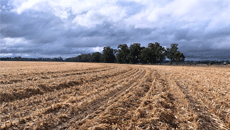
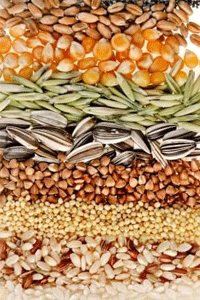
Grain SA met with agricultural machinery companies to address the cost of mechanisation to grain farmers and the sustainability thereof.
Discussions around LEAF services is ongoing and remains challenging. Various meetings have taken place to formulate comments on the LEAF proposal, which is due on 24 May 2021.
New wheat cultivars were evaluated, with Lima as new entrant to the seed market presenting six new varieties with an expected increase in yields. The ARC presenting four new varieties with some concern regarding quality though.
The industry maize grading meetings made good progress last week which can provide a lot of benefit to producers and address grey areas that are currently being experienced. The recommendations aim to also improve grading consistency. The final proposal will be submitted to the Forum Steering Committee.
Grain SA could not get a special dispensation approved by the Registrar of Act 36 to allow glyphosate spraying by air. Chemical organisations could not supply enough data and evidence for a special dispensation to be approved. More data will be gathered and the quest to legalise aerial spraying will continue.
The SACTA levy application for lupines was submitted to the NAMC for consideration and is a positive move towards alternative crops for the Western Cape.
Assistance to members with a dispute regarding pollination problems that have been experienced during the season is ongoing.
Fertiliser quality sampling in the Western Cape has commenced this week.
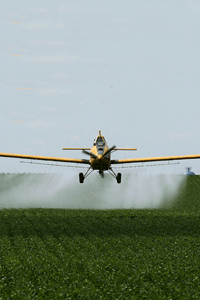
Pre-Harvest Aerial application of glyphosate-containing products over maize could not be legalised in time for the current season.
In the beginning of March 2021, it has come to Grain SA’s attention that maize producers in the main production maize regions of the Summer Rainfall area, have unknowingly been using an off-label aerial application to control winter weeds at pre-harvest over the crop, for effective winter weed control. The control action involves an aerial application of glyphosate after the maize crop has reached maturity / black layer stage and when it is difficult to control weeds, which are still in the rosette stage. This is a practice that is of large economic benefit to producers and is assisting with timeous production practices. Aerial application is paramount for sustainable production in the future and needed by our members.
In April, an Action Committee was established to investigate ways to urgently register glyphosate for this specific use. The Registrar of Act 36 of 1947 was immediately contacted by Grain SA to establish what would be needed for such an urgent application. Local residue data & a risk assessment was needed to be done for an urgent registration. Unfortunately no data has been gathered over the years to support this urgent application.
Although Grain SA tried and explored every single avenue to obtain a label extension for use during the current season. However, due to the fact that no data has been generated for the Registrar to be able to make a responsible decision, the urgent registration application could not be granted.
Nonetheless, each of the involved Registration Holders will endeavour to generate sufficient efficacy and residue data, to enable them to submit an application for approval of a pre-harvest aerial application of glyphosate-containing products at their earliest convenience (hopefully the registrations would be in place by the next season). Grain SA will continue to facilitate and to support the process to make sure all efforts is in place to get applications approved as soon as possible.
Click below to download the Action Committee Statement – May 2021
PRE-HARVEST AERIAL APPLICATION OF GLYPHOSATE-CONTAINING PRODUCTS OVER MAIZE
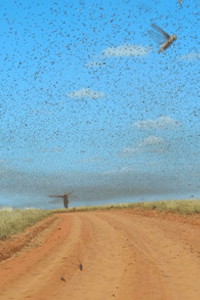
Brown locust outbreaks are occurring widely across the Northern Cape province and regions that share a border with the Free State. Producers are encouraged to inform the Department of Agriculture, Land Reform and Rural Development of the areas where locusts occur.
Report locust outbreaks to:
Read more or News24 here and on The South African here
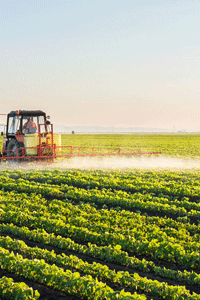
Following the report in March 2021, international agro-chemical and fertiliser prices have continued on an upward trajectory. South Africa, as an importer of these products, remain disadvantaged regarding price increases, however unlike a year ago when the Rand was R18.57, it has strengthened by 22.4%.
Tables 1 and 2 indicate trends in the prices of international agricultural chemicals (active ingredients) on the left and international prices in Rand value on the right. Between April 2020 and April 2021, the Rand has appreciated by 22.4%. The impact of the stronger Rand can clearly be seen below.
As indicated in table 1, there have been decreases for all insecticides of between 1.5% and 28% in Rand value. This trend is in contrast to the international price trend, which indicate increases for half of insecticides of up to 26% in dollar terms and those decreasing only moderately up to 7.6%. Naturally, South Africa usually follows the international price trend, however, the impact of the stronger Rand is seen by the magnitude of the decrease in Rand terms, while international prices are increasing.
Table 1: Insecticide prices: International in Dollar and Rand value
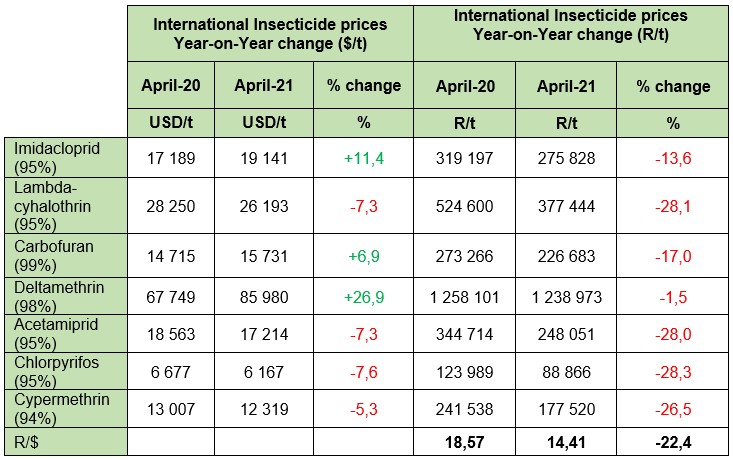 Source: Grain SA
Source: Grain SA
*Data as at April 2021
Herbicides in table 2 indicate a significant increase in the prices of all active ingredients by up to 35.9% in Dollar terms. Similarly a trend in Rand terms is seen, however, atrazine and trifluralin show a decrease of 2.8% and 19.7% respectively, from April 2020 to April 2021.
Table 2: Herbicide prices: International in Dollar and Rand value
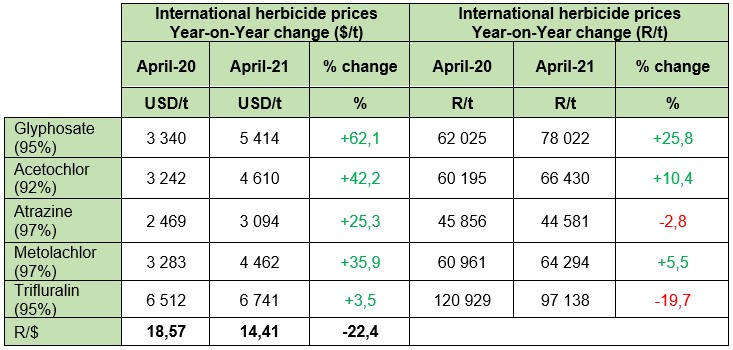 Source: Grain SA
Source: Grain SA
*Data as at April 2021
Fertiliser price trends
Figure 1 depicts international fertilizer prices in Dollar terms from 2012 to April 2021, together with the rand/dollar exchange for the same period. There is a significant upward trend in international fertilizer prices over the past year. Ammonia prices increased the most by 128%, followed by DAP 88% and Urea 51.2%, while KCL increased moderately by 17.8%. In Rand terms Ammonia, increased by up to 77.2%, followed by DAP 46% and Urea 17.3%, with only KCL decreasing by 8.6%. The moderate increases and even decrease in one active ingredient compared to the Dollar terms is an indication of the counter-effect of a stronger Rand.
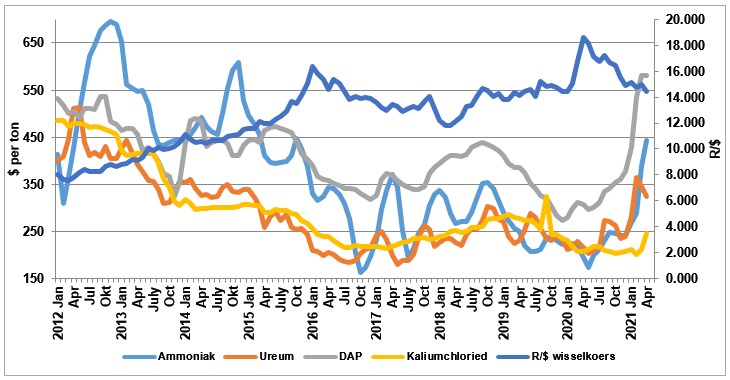 Figure 1: International fertilizer prices
Figure 1: International fertilizer prices
Source: Grain SA
*Data as at April 2021
Figure 2 depicts average domestic fertiliser prices since 2010. The past year May 2020 to May 2021, these are in line with international prices, showing an increasing trend for MAP 22.6%, LAN 11.7% and Urea 7%, while KCL has decreased by 15.4%.
 Figure 2: Local fertilizer prices (Average pricelist prices)
Figure 2: Local fertilizer prices (Average pricelist prices)
Source: Grain SA
*Data as at May 2021
Conclusion
Agro-chemical and fertiliser prices remain high due to demand in the Northern hemisphere for the planting season, fuelled by increasing commodity prices, with favourable weather in key consuming countries. Increases in the Brent Crude oil prices also drive up production- and transport costs. This international upward trend will probably linger for the next few months while the Northern hemisphere complete their plantings. Things will likely stabilise in the fourth quarter. The only saving grace for South Africa at the moment remains the strong Rand, which has reduced a bit of pressure on prices. However, if prices continue further up, it will be a challenge for the county’s 2021 summer planting season.
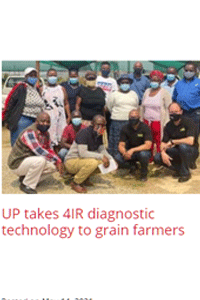
The Forestry and Agricultural Biotechnology Institute (FABI) at the University of Pretoria (UP) in collaboration with Innovation Africa@UP has partnered with various stakeholders to engage smallholder grain farmers to connect with the institute’s Diagnostic Clinic via its digital platform. This initiative is an attempt to bring fourth industrial revolution technologies to smallholder farmers across SA to help them increase their productivity and competitiveness.
“We hope to drive plant health management technology use and adoption in the forestry and agriculture industry that is inclusive and underpinned by high-quality specialist research support,” says Dr Osmond Mlonyeni, project manager at Innovation Africa@UP.
To this end, the institute developed disease diagnostic tools and services for its commercial partners, and is now in the process of adapting them for smallholder grain farmers around the country who are linked to FABI research partners. Diagnostic services include specialist laboratory support for pathogen and pest identification, information sources, reference collections and expert knowledge.
Jerry Mthombothi, development provincial coordinator for Grain SA, attended the workshop, and is looking forward to the roll-out of this project. “This initiative will help our farmers a lot because they will be in a position to know what problems their crops have, why they have those problems, the extent of the damage and what the remedy will be when they get the results back. If farmers can find solutions to crop problems as early as possible, that can help them to increase their yields and produce good-quality products.”
Alliances with various stakeholders, from industry and business partners to NGOs and governmental departments, have been formed in order to realise this initiative, which FABI is also planning to roll out to a group of smallholder farmers in the Eastern Cape. “Partnerships with Grain SA, Cropwatch Africa and Social Coding SA have been forged to provide specialist plant health services and training to these farmers,” says Dr Mlonyeni. “Other stakeholders that have provided a funding base include the Department of Science and Innovation, UNICEF and Future Africa.” A key stakeholder that is yet to become involved is the Department of Agriculture, Land Reform and Rural Development through their extension officers, he adds.
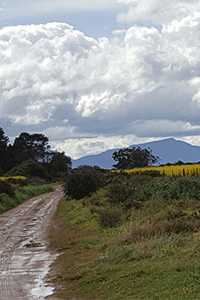
After the heavy rain measured a week ago over the Overberg / Riversonderdend area in particular, grain producers were a little concerned about the cold front of the past weekend and how much rain will fall again - especially in places where it already rained 300mm and more.
The Southern Cape measured between 15 and 40mm of rain, with the highest rainfall recorded at Swellendam. The producers are planting here in beautiful conditions, with many already far advanced and should complete the planting process within the next two weeks.
The Overberg received between 10 and 20mm of rain. However, these producers have not been able to really start planting again in certain areas due to too wet soils. Planting will take some time in this area. In the regions where 300mm and more have been measured, a lot of damage actually occurred and producers do not yet know whether the fields that have already been planted with canola, barley and wheat will have to be replanted or not. Several fields are also full of ditches as the water ran, with wetlands to be seen everywhere.
The Swartland, which missed the heavy rain of the previous week, measured between 10 and 35mm of rain over the weekend. The lowest rainfall was in the Eendekuil area with the highest rainfall in the Koeberg area. Producers are also far into planting, with most planting in dry soil from the 3rd of May. The belief is strong that the Swartland will start to turn green soon after the weekend as crops germinate and start growing. Those who are still planting currently experience very favourable conditions. The cold front that is predicted for the weekend could only be good news for the Swartlanders.
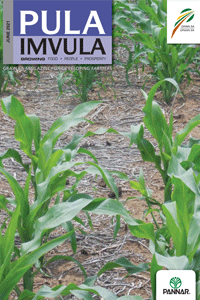
The latest issues of the 2021 June edition of Pula Imvula, Grain SA's magazine for emerging farmers, has been loaded on the website. Be sure to read any of the editions for the latest news and articles. Simply click on one of the links below.
| Pula Imvula English | Pula Imvula Sesotho | Pula Imvula Tswana | Pula Imvula Xhosa | Pula Imvula Zulu |
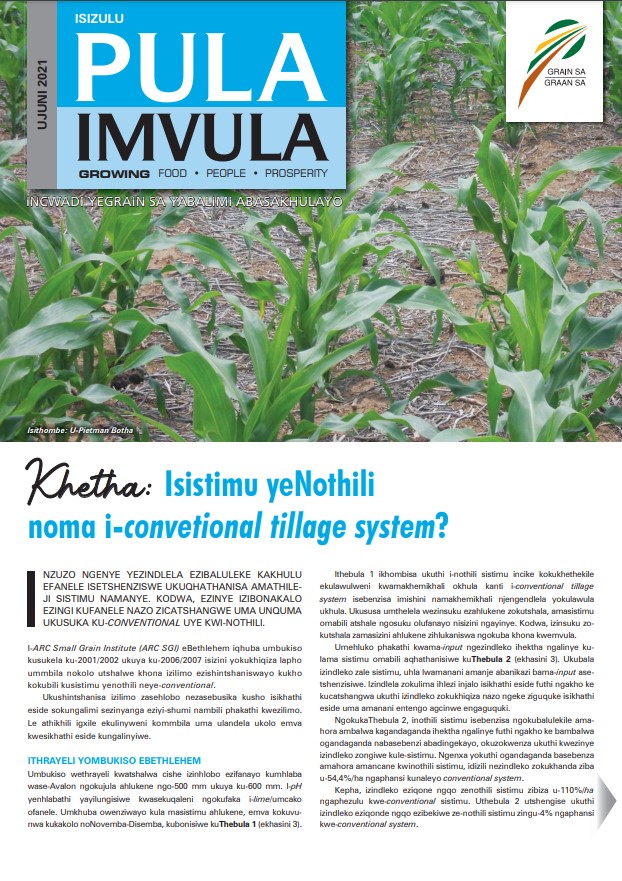 |